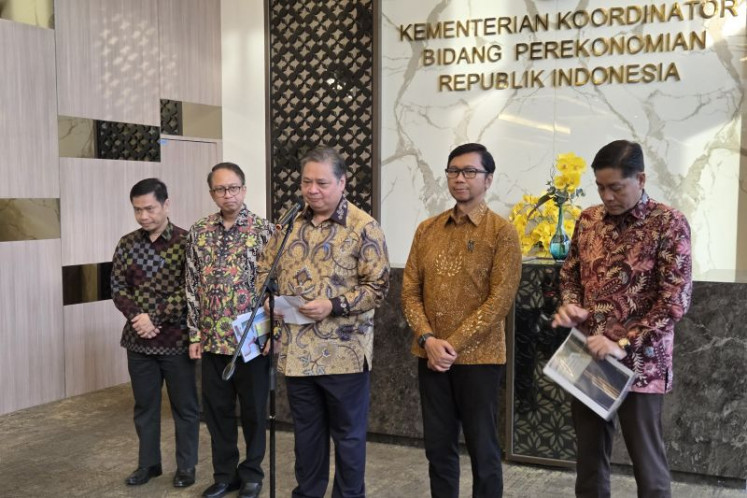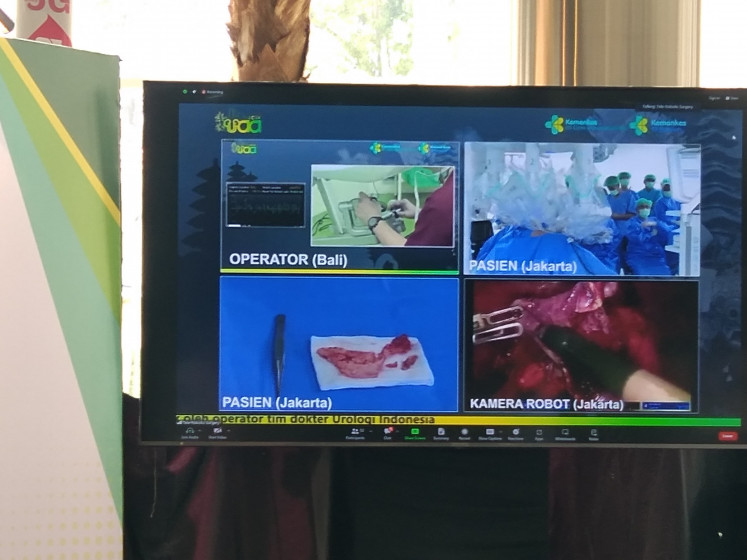Popular Reads
Top Results
Can't find what you're looking for?
View all search resultsPopular Reads
Top Results
Can't find what you're looking for?
View all search resultsAt Your Leisure: Surprise at Sumire
When the Asoka Hotel was demolished in the late 1980s, the people of Jakarta lost one of the city’s dearest Korean restaurants along with it
Change text size
Gift Premium Articles
to Anyone

When the Asoka Hotel was demolished in the late 1980s, the people of Jakarta lost one of the city’s dearest Korean restaurants along with it.
It was from Asoka’s ashes, however, that the Grand Hyatt Jakarta was built. And Jakartans smiled again.
The name of the Grand Hyatt signature Japanese restaurant–Sumire–has since bloomed like a fair cherry-blossom tree at a hanami festival.
Sumire means “beauty” or “jewel” depending on the kanji, or Japanese character. Indeed, when the restaurant’s name is uttered, images of flawlessness appear in the heads of Jakarta’s gourmands.
I had the chance to visit Sumire a few days ago after an extended absence. Walking in, I listened to the tap-tap-tap of the soles of my shoes on its wooden floors.
Sumire was as mesmerizing as it was during my last visit. There was the rustic smell, the dimly lit main dining room and the supremely kind front-of-house staff.
Activity swirled around the restaurant’s sushi bar and spacious teppanyaki counter as a row of shoji, or Japanese paper doors, marked the tatami (rice-straw mats) and private rooms behind.
I passed through a noren curtain divider. The dawn flower painted on it is also known as a sumire in Japanese, although the kanji character is different.
Ahead was part of the restaurant that was new to me: The bar that served tempura and kushiyaki, or grilled meat and vegetables.
This part of the dining room evinced a more modern ambiance, with floor lamps, a marble counter and a dry-twig decor offering a minimalist touch.
There are other kushiyaki restaurants in Jakarta, most notably Tori-Ichi, in the Little Tokyo district of Melawai in Blok M, or the impeccable Kushi-Yaki Umena Dori in Senayan, which offers a classic menu of momo (chicken thighs), torikawa (chicken skin) and negima (chicken and spring onions).
Sumire, however, affords guests an array of high-end kushiyaki, such as fine-grade beef tenderloin, fatty salmon and homemade tsukune chicken meatballs.
I ordered chicken, the true barometer of any kushiyaki chef’s skill. The lunch special came with wings, meatballs and liver, as well as with asparagus and the thick part of a spring onion.
As I tasted my first bite of chicken liver, I was impressed by its fresh, rich flavor. It is one of the most delicate ingredients to work with, developing unappetizing smell that leads to unappetizing flavor as it warms.
Careful handling and freshness is essential. It is something that Sumire executes very well.
Next was the chicken meatball, which I found packed with flavor: Slightly caramelized on the outside, juicy and glistening with moisture on the inside. The meat was not 100 percent finely ground, which turned out to be key to developing its juiciness and bites of texture.
Before I tried the chicken wing, the restaurant’s chef, Lukman Hakim, emerged to offer his signature condiment–an orange seed paste familiar to every Indonesian–sambal.
I was amazed and bewildered. How could a shrine of Japanese cuisine serve sambal? Was this a blasphemy against the sacred art of washoku, or traditional Japanese cuisine?
I dipped the glistening chicken wing into the sambal. A citrus aroma arose.
In a way equally magical and mysterious, the combination of a fiery, hot and sour chili sauce matched the kushiyaki. (See the “Side Dish” for more information on the origins of this unlikely pairing).
After the wonderful encounter with Lukman’s sambal, we tried Sumire’s assorted tempura cooked by a line chef in front of us.
He showed us the beauty of washoku, performing with the eloquent moves of a dancer: Carefully peeling vegetables, slicing sweet potatoes to the right thickness, tapping dry shisho leaves and cleaning shrimp.
Next, the chef combined batter, cold water and tempura flour to coat the ingredients before deep frying them in a sesame oil mix at 180 degrees until they were perfectly golden and crisp.
Sumire also serves MasuiZumi Sake, which comes in a bottle as iconic and as artisanal as the liquid within.
Masuda Shuzo, established in 1893 in Hokkaido, offers Masuizumi as a premium sake. It also has been brewing a junmai sake (without additional alcohol) since the 1960s.
Much like Sumire, the brewers stick to tradition, starting work each year on Tai-an, an auspicious day of the Buddhist calendar in October.
“Adaptation is needed to ensure our existence for the future, but of course we have to always stay close to our roots.” Agung Budi, the executive sous chef of the Grand Hyatt Jakarta, said.
It is that adherence to tradition that has kept Sumire as one of the finest Japanese dining establishments in Jakarta.

SIDE DISH
After dining at Sumire, J+ sat down with two of the chefs responsible for the restaurant’s exquisite cuisine: Lukman Hakim, chef du cuisine, who has been working at the Grand Hyatt Jakarta since 1992, and Agung Budi, executive sous chef, who has been there for three years. Here are excerpts of the interview.
How has the taste of Sumire’s guests evolved?
Lukman: The early customers of Sumire Jakarta were Japanese expats. We also had a Japanese chef to lead the team. The food was 100 percent authentic Japanese, which at that time was quite unfamiliar to our local taste buds. As time went by, we needed to adapt if we wanted to survive. The guests at that time were always in good attire–suits, nice Oxford shirts with blazers, and long dresses and jackets for the ladies. Today, customers seem to be more casual. The good side is that today’s customers–half are locals–are more flexible when it comes to menu choices, perhaps because their palates are getting more and more developed over time.
How do you balance traditional and fusion in your cuisine?
Budi: The Japanese are strict about their roots–and that is what we always stick to. Sumire’s identity is as a traditional Japanese restaurant that serves the best that we can with the finest ingredients. We source our ingredients from responsible farmers. At the Grand Hyatt, we are really required to always use sustainable ingredients. Those kinds of values that we believe in have kept Sumire in existence until now.
Lukman: For us identity is important. Yes, of course, we have to adapt–but adaptation doesn’t mean that you permit major changes. We have great human resources that always stick to the SOP [standard operating procedures]. In that way, the quality of Sumire’s dishes will always meet our standards. Like chef Budi said, that quality and Sumire’s standard are what keep this restaurant existing–regardless of the new Japanese restaurants opening all across the city.
What’s the idea behind Lukman’s sambal?
Lukman: Before I came up with this sambal, some of our local patrons loved to ask for some extra chopped chillies and soy sauce. As time went by, I started thinking about the idea of an additional sambal–just in case some patrons might ask [for it]. Then the idea for this sambal came to me. Since then this sambal, known by people as sambal Lukman, started its hidden fame among our loyal customers.
This is definitely off the menu–and not just at Sumire. Now guests can ask for this sambal at every outlet at the Grand Hyatt Jakarta, from C’s to the Grand Cafe.
_________________
SUMIRE
Grand Hyatt Hotel
Jl. M.H. Thamrin, Jakarta
Phone: +02129921431
Email:jakarta.grand@hyatt.com
Lunch 12 p.m. -3:30 p.m.
Dinner 6 p.m. -10:30 p.m.









